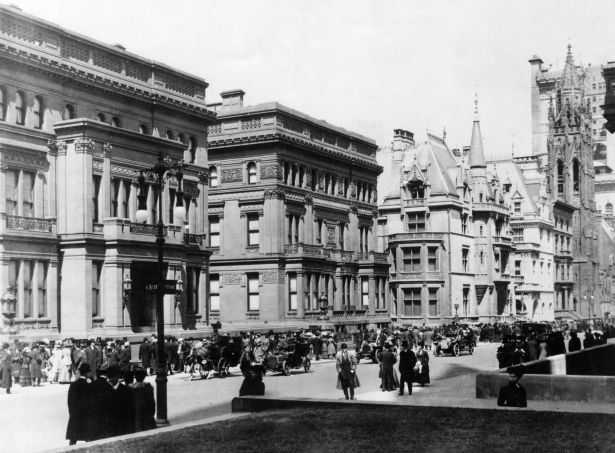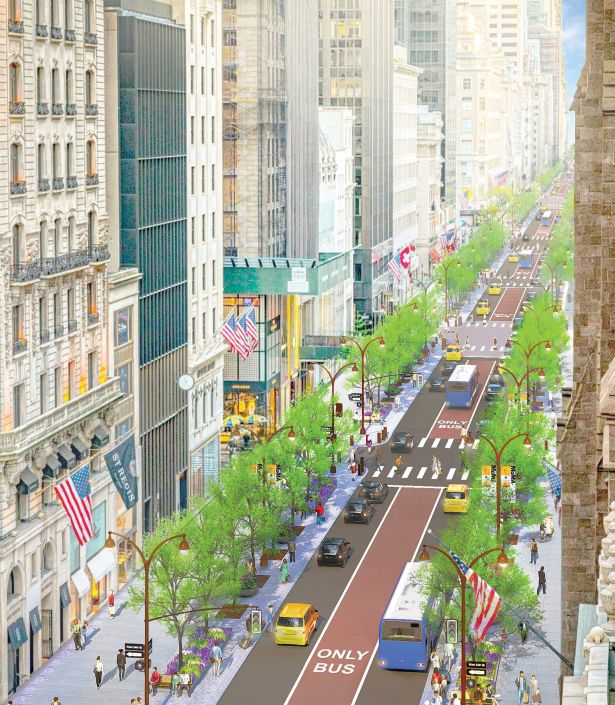New York’s Fifth Avenue Redesign Will Boost the Retail Revival There
Ground-floor businesses along the storied boulevard have experienced a beefy, if uneven, rejuvenation since the pandemic
By Amanda Schiavo August 13, 2025 6:00 am
reprints
Alexa, play the song “Fifth Avenue” by the pop band “Walk Off The Earth.”
Arlie DeMeo is a lifelong New Yorker with an appetite for international travel, so in October of 2023 she packed her bags and headed to Tokyo, wanting to drink in all the sights and sounds, including a visit to the city’s upscale shopping, dining and cultural district, Ginza. What she didn’t expect was to enter a neighborhood in Tokyo and immediately feel like she had been transported back to a certain boulevard in Manhattan.
“We rounded the corner in Japan and then suddenly we were back on Fifth Avenue,” she said. “It was like time travel.”
That’s the power of Fifth Avenue: You could be halfway around the world and be reminded of what is arguably that world’s most famous street. Fifth Avenue is a global brand in and of itself, perhaps more so than the luxury retailers that call it home.
The brand is about to get some significant polish, too. The city is pursuing a major redesign of its prime blocks, one that commercial real estate professionals say is overdue and that will make its properties — especially of the retail sort — that much more desirable.
In 2024, New York Mayor Eric Adams, in a public-private partnership with an organization called The Future of Fifth, unveiled plans for a $400 million redesign of the stretch of Fifth between Bryant Park and Central Park.
There are iconic boulevards all over the world — the Champs-Élysées in Paris, London’s New Bond Street in Mayfair, Calle Florida in Downtown Buenos Aires, the Via dei Condotti in Rome — and it is the city’s goal to make Fifth Avenue stand out even more among that pack.
Construction on the fully funded redesign led by engineers Arcadis and TYLin (formerly Sam Schwartz), as well as the architectural firm Field Operations, is set to begin in 2028, according to the city.
As it stands, Fifth Avenue is 100 feet wide, with five traffic lanes and two 23-foot sidewalks.

When all is said and done, the new stretch of Fifth Avenue will feature sidewalks that are 50 percent wider than the current width, with an expansion of the unobstructed walking space to 25 feet on each side and an additional 8.5-foot-wide section for trees — imagine a play on La Rambla in Barcelona. The new Fifth Avenue will also feature 20,000 square feet of planters, new public seating, new public activity space and improved lighting. The plan calls for a reduction in bus lanes — something those working toward the beautification of the street welcome with open arms.
“Toward the end of the de Blasio administration, his team had proposed limiting all car traffic on Fifth Avenue from 60th to 42nd, and increasing bus traffic,” said Edward Hogan, chairman of the board of the Fifth Avenue Association, a nonprofit established in 1907 with the goal to oversee policy and placemaking decisions on Fifth Avenue. “We fought that as an association whose mission is to serve the beauty of the street. There’s no luxury street in the world that has a bus highway running down the middle of it.”
The three traffic lanes will be split up with one dedicated to cars, one to buses, and the other will be a mix of both, Hogan said.
“The goal of our plan was to make Fifth Avenue a more beautiful place, to bring down the chaos of the avenue and slow down everything so the pedestrians can walk up and down the avenue,” he added. “The wider sidewalks will allow for retailers to put cafe seating in front of their stores — actually having people stay on Fifth Avenue, sit on Fifth Avenue, and take in the avenue.”
Retailers along Fifth Avenue are excited that what is going on outside of their stores will soon match what they have created inside, Hogan said, noting that retailers had begun to feel that the luxury experience they were creating stopped as soon as clients stepped out their doors and back onto Fifth.
“Brands have spent more money on their Fifth Avenue stores than they have on many of their other store [locations],” Hogan, who also serves as the executive vice president and head of retail leasing at Vornado Realty Trust, said. “I started to notice in 2017, 2018 that brands would say the avenue doesn’t match what they are doing inside their stores. But, if you were to step out of the store in SoHo or Meatpacking, the streetscape, the atmosphere is more on brand.”
Fifth Avenue and luxury retail are like chocolate and peanut butter, they just go together. So it makes sense that business owners would want to extend that luxury experience out onto the avenue clients will use to visit their shops.
“Retail, in essence, is what made Fifth Avenue famous,” Michael Shvo, founder and CEO of the real estate development firm Shvo, said. “Retail is the one asset class that really touches the most people, but Fifth Avenue also has some amazing landmarks as part of what made it famous.”
Shvo has three properties on Fifth Avenue. The Mandarin Oriental Residences at 685 Fifth Avenue is a luxury residential building. The former headquarters of Coca-Cola at 711 Fifth Avenue is Shvo’s 18-story office property, which, in partnership with famed designer Peter Marino, was reimagined into a Class A office space.
And the firm’s third property is located within the famed Crown Building at 730 Fifth Avenue. Shvo, in partnership with Russian developer Vladislav Doronin, acquired 21 floors of the Crown building in April 2015 for $500 million. Those 21 floors have been transformed into the Aman New York, a luxury property that offers 85 hotel rooms as well as 20 condos.
Jeff Sutton, founder of Wharton Properties, alongside General Growth Properties, acquired the Crown Building in 2014 for $1.75 billion. Sutton sold the majority of Wharton’s stake in the Crown Building’s retail element to Brookfield Property Partners in August 2019 for $779 million, The Real Deal reported.
Fifth Avenue has been a place synonymous with luxury and opulence since the 19th century’s Gilded Age, when movers and shakers like the Vanderbilts, the Astors and the Rockefellers all had mansions occupying the avenue from 42nd Street up to 59th Street, said historian Kevin Draper, co-founder and chief experience officer at New York Historical Tours.
But some of the recent history of Fifth Avenue hasn’t been all glitz and glamour. Several notable retailers had to close their doors between 2017 and 2020. Ralph Lauren’s 36,000-square-foot Polo flagship clothing store at 711 Fifth closed; Versace also shuttered its flagship at 647 Fifth; Massimo Dutti, The Gap, Lord & Taylor and Henri Bendel — which had occupied a place on or near Fifth Avenue for a century — all closed their doors due to high rents and less demand for brick-and-mortar retail.
Asking rent along Fifth Avenue — specifically 49th to 60th streets — hit $2,250 per square foot in 2017, according to Cushman & Wakefield’s “Main Street Across The Globe” report for that year. The 2024 data showed asking rents of $2,000 per square foot.
Still, that figure made Fifth Avenue the second most expensive street in the world after Milan’s Via Monte Napoleone ($2,047 per square foot).

The period between 2017 and 2019 has been dubbed “the retail apocalypse.” It was a period where retailers hadn’t begun to understand how to balance brick-and-mortar stores with the massive surge in online shopping — something they wouldn’t really get a handle on until the post-COVID-19 era, said Gene Spiegelman, a partner and retail leasing guru at Ripco Real Estate.
“What was happening in 2017, 2018, 2019, up until COVID — and COVID really is its own story — was this void and stress within the retail environment, which was exacerbated by COVID,” he said. “But I always look at Fifth Avenue as a street that lives past the vagaries of market trends.”
Spiegelman has been leasing retail space along Fifth Avenue throughout his more than 30-year career, and over that time he has seen the street go through a number of cycles and trends.
“From a leasing perspective, when I started in the business, there were lots of banks, there were lots of travel agencies, lots of discount shops and tourist shops on Fifth Avenue, as well as retail brands,” he said. “And then over time the street has [evolved].”

Retailers have gotten a better handle on how to balance e-commerce demand and brick-and-mortar profits, Spiegelman said. In that period between 2017 and 2019, there was a lot of demand for physical space, which drove up rents, but the e-commerce craze hurt that aspect of retailers’ business.
“What happened is sales started declining at brick and mortar, so retail started hesitating. They didn’t want to make big lease commitments, and vacancies increased. It was harder to lease space or have higher rents,” he said. “Then COVID came and it had two major impacts, one good and one bad. We saw tens of thousands of stores close as businesses went bankrupt. It was a different type of apocalypse. But what it also did was it taught retailers how to efficiently operate brick and mortar and online businesses.”
Now that the “retail apocalypse” narrative has come to an end, businesses are making greater investments in their physical presence, particularly the sort of luxury brands along Fifth Avenue.
Over the last two years Fifth Avenue has seen a wave of investment. Since 2023, there have been 10 real estate sales, totaling $3.9 billion, according to Mayor Adams’s office.
Rolex is developing a $250 million 30-story flagship at 665 Fifth Avenue; and Prada acquired a handful of buildings on Fifth Avenue, one at 730 Fifth Avenue, another at 724 Fifth Avenue and one at 720 Fifth Avenue. And, Kering, the owner of brands such as Gucci and Balenciaga, paid almost $1 billion for 711-715 Fifth Avenue.
That’s not all. Louis Vuitton is rebuilding its store at the corner of Fifth Avenue and 57th Street; jeweler Harry Winston made major renovations to its Fifth Avenue location; and both Swarovski and Chanel opened their first flagship stores in the U.S. on Fifth Avenue — all in the last couple of years.
So it’s not just the city investing in beautifying Fifth Avenue. The brands that call it home are making their own investments, bringing both upscale products and a luxury property experience to this market just ahead of the city’s redesign.
“Fifth Avenue is the most expensive and the most recognized retail street in the world,” the Fifth Avenue Association’s Hogan said. “There’s no other street in the world that has higher name recognition than Fifth Avenue, and it’ll be interesting to see, when you set a mission and stick to it, the impact this will have.”
Amanda Schiavo can be reached at aschiavo@commercialobserver.com.
UPDATE: This story was corrected to reflect that Fifth’s sidewalks are expanding by 50 percent rather than doubling.



